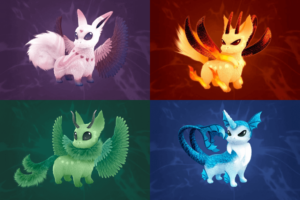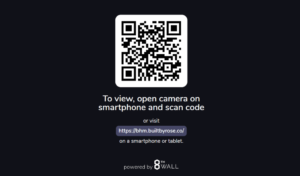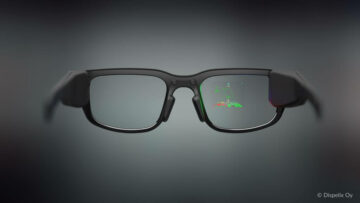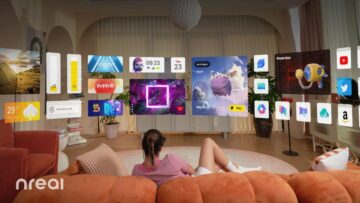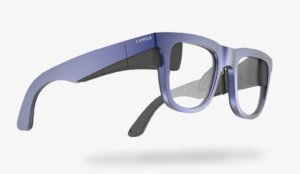First technologies emerge, and then they converge. Blockchain and extended reality technologies have been knocking on one another’s doors for a while now and doors are starting to open. Two examples happened to take place just recently, both using Snap Lens Studio to create wearable NFTs.
First, What’s an NFT?
“NFT” is short for “non-fungible token.” While these words and letters are increasingly being thrown around by everyone from artists to technologists, the term’s roots are in fintech so we’ll forgive you if they’re not familiar. If you’re already on board, just skip ahead while we break up the acronym into “token” and “non-fungible.”
“Token” comes from the blockchain world. Without getting too deep into that rabbit hole, a token is a unique string of characters that a computer comes up with, in the process of recording and packaging long strings of data. As a result, each token that is created is completely unique because of its having been created as a process and product of the blockchain.
“Non-fungible” is a finance language for “one-of-a-kind.” Something that isn’t fungible can’t be replaced and one of them isn’t as good as another. Take any given physical coin, for example. It is valuable precisely because it has an established price – it’s worth exactly as much as an identical gold coin and if there aren’t enough coins about, then more can be made.
So, a non-fungible token is a priceless coin. That is to say, it isn’t worth a set amount of money because money is based on scarcity and every NFT – being completely one-of-a-kind – has infinite scarcity. So, it’s worth whatever anyone is willing to pay.
Where Does XR Come In?
Now that we understand NFTs, where does XR come in?
XR – whether we’re talking about augmented reality, mixed reality, or virtual reality – explicitly involves the use of digital goods. Prior to the advent of non-fungible tokens, digital goods didn’t really have scarcity (with a few reasonably obscure exceptions). Any digital good could essentially be counterfeited.
As we increasingly spend time in virtual environments, we place mounting value on our digital lives and our digital goods. It makes sense that we want to have a more secure feeling that some of those digital goods are as unique to others as they feel to us, and creating NFTs of digital goods is one way to do that.
One great example came out of the first-ever WebXR Awards less than two months ago. The Polys Awards that were given out were completely digital and were deliberately designed to be impossible in actual three-dimensional space but digital models were made available photo opportunities in the metaverse. The “real” Polys are NFTs only given to the recipients.
While a blockchain-backed award is cool, it’s only one example of the potential for non-fungible tokens being a sign of value in an increasingly virtual world. Think, for example, about fashion in virtual spaces.
NFTs and Virtual Fashion
“Social media users have been hungry for virtual fashion and goods for some time now, a trend that ramped up during the pandemic,” Byte Director of Technology, Isabel Perry, said in a release shared with ARPost. “It’s clear that NFT-powered digital ownership is something that brands need to start thinking about.”

Byte is a marketing technology company that recently merged with award-winning international digital agency Dept. Byte recently created non-fungible tokens of limited edition jackets that users can purchase. When users purchase the NFT, they receive exclusive access to a video render of the jacket and Lens Studio design files.
Specifically, the Dept jackets use the full-body tracking that Snap has been gradually rolling out over the last few months with the most recent updates coming with Lens Studio 3.4. Earlier editions of Lens Studio allowed full-body gesture controls that triggered certain effects but they weren’t able to convincingly track the body to the level required for wearables like Byte’s jacket.
“Now that Snapchat has released its new body-tracking tool, people are better able to showcase their virtual items across social platforms,” said Perry.
Byte and Dept’s non-fungible token jackets are essentially a proof-of-principle – “a way of powerfully showcasing the future of shoppable AR,” as Perry put it.
The virtual jackets are also part of Byte’s drive for more environmentally sustainable fashion. They were even minted on Hive, a blockchain thought to be more energy-efficient than Ethereum – the blockchain many NFTs including the Polys are minted on.
However, they aren’t the only wearable NFTs out there.
Virtual Fashion as Dialogue
Snap Lens Creator Justin Melillo also used Snapchat as a backbone for his wearable NFTs that he calls a response to the “Lil Nas X Satan Shoe.” The shoes, which incorporate satanic imagery and fake blood in the heels, have led to some strong reactions – not least of which a lawsuit that saw the shoes recalled.
“In response to his design, I decided to provide an opposing, contrasting look – the Angel Shoe,” Melillo’s website says of the virtual shoe with wings on the heels and a halo over the toe.

According to Melillo, the virtual shoes have been “worn” by over 4 million users. You can try on the shoe for free or purchase the NFT on OpenSea.
When Emerging Technologies Become Converging Technologies
This article isn’t about Snapchat, but it’s definitely worth discussing that both of these projects were created with Lens Studio. As the top social AR platform, Snapchat is widely attributed as being a huge onboarder in terms of getting people interested in AR more broadly.
By making Lens Studio more user-friendly, Snap has actively tried to make AR production as well as experience more accessible. While even they might not have seen this exact scenario coming, Snapchat NFTs could be the moment that the genie leaves the bottle in terms of a marketplace for virtual fashion.
Source: https://arpost.co/2021/04/15/byte-justin-melillo-snapchat-world-of-nfts/
- access
- active
- apparel
- AR
- around
- article
- Artists
- Augmented Reality
- blockchain
- blood
- board
- body
- border
- brands
- Campaign
- CNN
- Coin
- Coins
- coming
- company
- Creating
- creator
- Customers
- data
- Design
- digital
- Director
- ethereum
- Exclusive
- extended reality
- fake
- Fashion
- finance
- fintech
- future
- Gold
- good
- goods
- great
- Hive
- How
- HTTPS
- huge
- Hungry
- Including
- International
- IT
- language
- Led
- Level
- Limited
- Long
- Making
- Marketing
- marketplace
- Media
- Metaverse
- million
- mixed
- mixed reality
- money
- months
- Newsletter
- NFT
- NFTs
- non-fungible tokens
- open
- Others
- packaging
- pandemic
- Pay
- People
- Platforms
- price
- Product
- Production
- projects
- purchase
- reactions
- Reality
- response
- sense
- set
- shared
- Short
- Snap
- snapchat
- So
- Social
- Space
- spend
- start
- sustainable
- talking
- Technologies
- Technology
- The Future
- The Metaverse
- Thinking
- time
- token
- Tokens
- top
- track
- Tracking
- Updates
- us
- users
- value
- Video
- Virtual
- Virtual reality
- virtual world
- wearables
- Website
- webXR
- words
- world
- worth
- X
- XR

